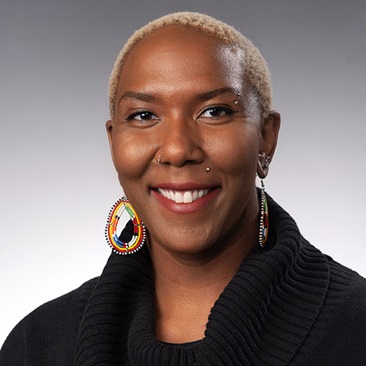Maxwell Experts Discuss Future Implications and Historical Context of Dobbs v. Jackson Ruling
July 20, 2022
Syracuse University Today
In a recent panel discussion, faculty experts from the Maxwell School shared expertise and insight on the recent Supreme Court ruling in Dobbs v. Jackson, which overturns the precedent set by Roe v. Wade of abortion as a constitutional right.
Organized by Maxwell’s Center for Policy Research, the discussion was moderated by the center’s director, Shannon Monnat, professor of sociology. Panelists included political scientists Shana Kushner Gadarian, Jenn Jackson and Thomas Keck, as well as Carol Faulkner, professor of history and associate dean for academic affairs, and Sarah Hamersma, associate professor of public administration and international affairs.
The discussion covered the history of governing abortions in the U.S.; how the Dobbs v. Jackson decision might affect access to abortion and other reproductive services; impacts the decision could have on economic and health outcomes and voting behaviors in upcoming elections; and what precedent this decision might set for other Supreme Court decisions going forward.
In her opening remarks, Faulkner provided a nuanced historical context for the ruling, referencing a brief submitted in Dobbs v. Jackson by the American Historical Association and the Organization of American Historians.
In the post-revolutionary U.S., the nation widely adopted English Common Law, which only criminalized abortion after “quickening,” or when fetal movements are felt, around four months. Until the mid-19th century, decisions about abortion were left primarily to women and could be obtained by visiting a pharmacy or apothecary to purchase herbal medicines to “restore menses.”
Faulkner explained that criminal abortion statutes emerged from the newly formed American Medical Association’s opposition to abortion as a means of stripping control from the home and from those who were not formally trained medical practitioners. And, she said, statutes were not necessarily motivated by concern for the fetus, but instead the belief that white Protestant women were not having as many children and the country would soon be overtaken by the children of Catholic immigrants.
“The historians point out that such biased arguments in favor of criminal abortion statutes are constitutionally impermissible,” said Faulkner, who studies the history of the 19th-century United States with a focus on women, gender, sexuality and social movements.
Panelists said it’s important to understand the ruling’s impact on the working class, those living at the poverty level, people of color, LGBTQIA+ individuals, people who are incarcerated and others who belong to one or more marginalized groups.
“When we think about the 14th Amendment and the idea of equal protection and due process, that’s a Reconstruction amendment…meant to solidify the idea that Black folks were no longer property, but they were people,” said Jackson, an assistant professor of political science with faculty affiliations in African American studies, women’s and gender studies and LGBT studies. “So, when we think about the history and the connectedness this decision has to our deep history of racial enslavement and the long arc of slavery in this country, we have to also consider the fact that this is not without intention and not without design.”
Hamersma, who studies the health and economic implications of social policies in the U.S., shared data citing the most common reasons for abortions as financial and personal constraints. “We may think of some of these as social constraints, or at least policy-sensitive constraints, such as employment, educational and financial consequences of childbearing in a society that devalues caregivers,” she said, emphasizing the importance of programs like prenatal WIC (Special Supplemental Nutrition Program for Women, Infants and Children) and SNAP (Supplemental Nutrition Assistance Program), along with expanded parental leave and more equitable medical care at birth.
Panelists also talked about the apparent discordance between the Court’s opinion and public opinion. Gadarian shared data showing that 35 to 40 percent of Americans support all abortion rights, and around 25 percent oppose legal access to abortion for any reason.
Keck, Michael O. Sawyer Chair of Constitutional Law and professor of political science, said that due to cycles of partisan alignment and realignment, the Supreme Court has fallen out of step with public opinion in the past. During the Great Depression, for instance, President Roosevelt and his Democratic Congress passed new, widely supported labor laws that were repeatedly struck down by the Supreme Court. “The American public is only going to tolerate a Court that is wildly at odds with public opinion for so long,” he said. “So that is something that the Court is probably going to have to pay attention to sooner or later.”
Gadarian, Merle Goldberg Fabian Professor of Excellence in Citizenship and Critical Thinking and professor and chair of political science, said alignment with a major political party is increasingly intertwined with individual views on abortion.
“At the time of the Roe decision, the parties were growing apart ideologically, and we see this also with abortion opinion,” she said. “So, while the parties themselves looked pretty similar on abortion policy in the 1970s, they’re very different now in terms of the kinds of policies that they support, and you see that reflected in the public.”
She said it is up to political candidates to talk about what’s happening at the state level, where decisions about abortion access will be made. She also emphasized the role of issues like gerrymandering and voting rights on state-level policymaking. “We’re seeing a move toward more restrictions even in places with publics that are supportive of abortion rights, and that is because of the way the states themselves are gerrymandered,” Gadarian said. “Many of the state legislators are insulated from accountability and being pushed out of office because of their positions on issues like abortion.”
Could the logic used in the majority opinion on Dobbs v. Jackson roll back other protections, like same-sex marriage or the availability of contraceptives?
“We know that the logic of the Court’s recent opinion threatens other constitutional rights as well,” Keck said. “Which does not mean that all of those other constitutional rights are now going to fall, because the Court doesn’t operate solely on the basis of legal logic.”
Jackson said they talk to young Black and Brown people across the gender spectrum in the U.S. who already have a “very fraught relationship with reproductive justice in this country.” They are fearful about what Dobbs v. Jackson might mean for other protections that help keep them safe. “People don’t want to go back to a place where abortions and reproductive care are things that we do in the shadows,” they said.
Jackson encouraged grassroots activism. “Get local and find out what’s happening in your neighborhood, in your community, where you pay taxes,” they said. “And really start to dig into the ways that you can change the environmental and political conditions that are facing people where you are. That’s where you have the most power.”
Watch the video of the full event via YouTube.
Related News
Commentary

Dec 3, 2025
Commentary

Dec 2, 2025






